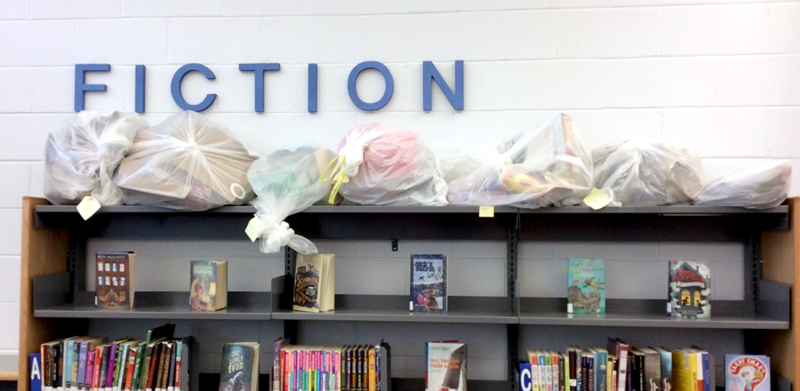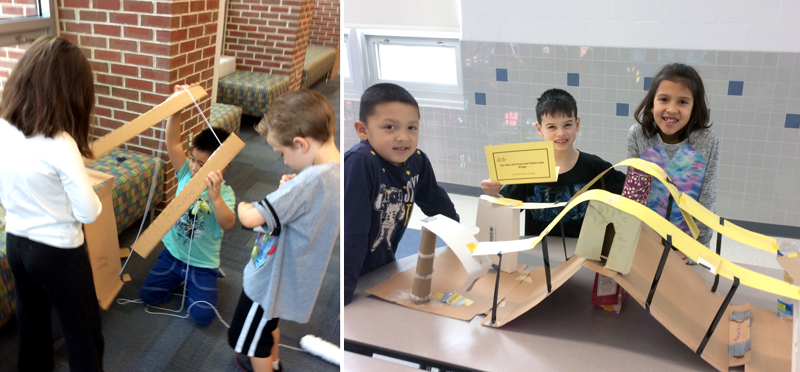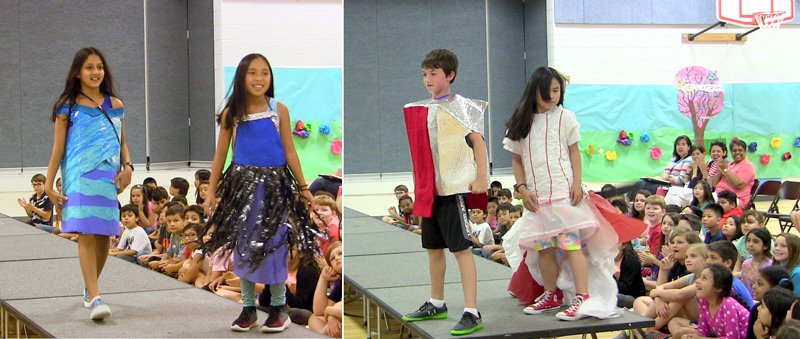Eight Project-Based Learning Activities for Your School Library
An elementary school librarian’s suggestions for projects related to animal habitats, natural disasters, bridge building, recycled fashion, and more.
 |
Storage for project-based learning creationsPhotos courtesy of Maura Madigan |
One person’s trash is another’s treasure. That saying could certainly apply to my library. Some may wonder why the bookshelves are topped by recycled materials and trash bags. This material is actually project-based learning (PBL) projects in progress. As the librarian of North Springfield Elementary School, a PK–5 school in Springfield, VA, I facilitate at least one PBL project per grade each year. That means finding places to store and display 60-plus projects at a time.
What is PBL?
Project- or problem-based learning starts with a “Driving Question” or problem to guide student research and exploration. For example, our fourth grade natural disaster project asks the question, “How can you, as part of a national task force, create a product or innovative idea to help save buildings and lives?” PBL projects are usually hands-on, open-ended, student-led, and involve choice. The emphasis is on the process rather than the product, with students learning as much from their mistakes as their successes.
Why PBL in the library?
I teach every student every week. This access, combined with a flexible curriculum, provides incredible opportunity and responsibility. I carefully consider how to make the biggest impact: What can I offer that students don’t necessarily get from their classroom teachers? In the library, students can work at their own pace with easy access to resources. Since their projects aren’t tied to grades, they may be more inclined to take chances and challenge themselves without fear of failure.
 |
The Building Bridges project |
Benefits
All my PBL projects have a hands-on component in which students physically create something. This increases engagement and allows students to show different strengths. Each initiative targets multiple curriculum standards and skills, such as collaboration, communication, critical and creative thinking, and resiliency. Learning how to work in a group, compromise, innovate, and overcome setbacks are all essential life skills that kids practice during PBL projects.
When students are working on projects in my library, it’s messy and noisy, but it’s also purposeful and productive. I’m constantly surprised by what my students create, like the second graders who made a suspension bridge using VHS tape for cables and those who built a cantilever bridge using plastic Base Ten rods.
There were also the fourth graders who built an avalanche safety kit complete with a mock oxygen mask, homing signal, and thermal vest. For the Water Bottle Innovation PBL, clever products ranged from simple—a cheese grater—to more complex: a delayed water delivery system for plants.
Obstacles
The biggest obstacles are time, space, and resources. With my principal’s approval, I tackled the first by separating book checkout time from my 30-minute library block (Teachers bring their classes for 15 minutes just to check out books.) Setting up the projects on tables before students arrive saves time. I also factor in five minutes at the end for cleanup to help with transitions between classes.
Before I had a dedicated makerspace, it was challenging to find places to store materials and works-in-progress. I began with two rolling carts of recycled materials and supplies. Now a small room within the library acts as a makerspace, and in-progress and finished projects sit on the shelves.
Suggested Supplies:
|
Most of the materials are recyclables I bring from home or gather from school. I’ve collected old math manipulatives, broken scales, and more items that were no longer needed. I purchase other consumable supplies, like glue and tape, with library funds. Students use materials from the makerspace for all of their PBL projects.
Flow
Once the project gets underway, I take a back seat, checking in periodically to gauge progress and offer minimal feedback. I provide a timeline with deadlines and have each group make a list of what needs to be done and by whom. Some groups may not finish—this is OK, and can also provide valuable lessons. All groups present their projects at the end. We invite teachers, other classes, and parents. Kids know they have to present whether or not they finish their project. Last year, several fourth grade groups gave up recess time or came to school early to work on recycled fashions.
 |
At the Trash to Panache fashion show |
Projects
My first year, I started by modifying two projects—Recycled Fashions (fourth grade) and Water Bottle Innovation (fifth grade)—that I’d designed as a classroom teacher. The next year, I created new projects—Building Bridges (second grade), Animal Habitats (third grade), Natural Disasters (fourth grade)—and borrowed ideas for kindergarten and first grade from colleagues.
Shelving a number of books on tsunamis, tornadoes, and hurricanes gave me the idea for the Natural Disaster project. I chose fourth grade because they study weather. This was a collaborative effort with students doing the project in both the library and classroom. Because they could work on projects every day in class, they were finished in two to three weeks as opposed to the eight to 10 it would take working in the library alone. During post-project reflection, teachers suggested limiting the choices to weather-related disasters in order to better align with their science standards.
A Chair for Goldilocks (kindergarten): Following an extensive study of fairy tales, students build “just right” chairs for Goldilocks. I have a doll that students use to size and test their designs. I need help from the teachers and assistants to manage this project. It’s impossible for one librarian to supervise the makerspace, oversee the glue gun, and ensure the kindergarteners aren’t stapling their fingers.
Plant with a Purpose (first grade): After studying parts of a plant with their teachers, students create plants that do something other than give off oxygen and look pretty. Students made models of plants using various materials that could set the table, comb their hair, and sing them to sleep. This exercise was created by Valerie Jopeck Fairfax, elementary education specialist, library information services, at Fairfax County Public Schools( FCPS).
American Ninja Warrior Geometry (first grade): Students demonstrate their knowledge of shapes and simple machines by working in small groups to design and build models of new obstacles for the show America Ninja Warrior. Created by FCPS first grade teacher Victoria Reidenbaugh and STEAM teacher Mia Leone, this is a collaborative effort with students working on the project in their classrooms and the library. Reidenbaugh teaches lessons on simple machines and Leone designs an obstacle course for students to explore before they plan and build.
Building Bridges (second grade): Students build freestanding bridges that can accommodate a four-inch boat underneath and bear one pound of weight on the deck. When finished, they name their bridges and list materials used, steps taken, and setbacks.
Animal Habitats (third grade): Each group researches a different animal habitat (desert, ocean, grassland, rainforest, deciduous forest, lake/pond, river/stream, wetlands). Next they build models of their habitats and invent new animals, explaining the behavioral and physical adaptations. One group created a “hawkupine” —part hawk, part porcupine—for their forest habitat. Another made a self-sufficient animal, the “fruit raintree crab,” which has a tree growing from its head to provide food, water, and shade in the desert habitat.
Natural Disasters (fourth grade): Students research the causes and effects of natural disasters. They then create innovative products or ideas to protect people and buildings from these disasters. A few groups had the idea of building houses that withstand tornados, hurricanes, or tsunamis with reinforced materials like titanium. One went tech with an app idea that issues a tsunami alert and guides people to safety.
Recycled Fashions (fourth grade): Each group member makes an article of clothing or accessory around a common theme using recycled materials. Students use fashion books and magazines for inspiration. Items ranged from hats, ties, and handbags to floor-length gowns made from plastic grocery bags.
Water Bottle Innovation (fifth grade): Students are challenged to find innovative, useful, and cost-effective ways to re-use water bottles by creating new products. Past products include a cell phone case, salt and pepper shaker, first aid kit, and even running shoes.
Here are step-by-step guidelines for two PBL projects. The Driving Question and Steps portions can be distributed to students.
Natural Disaster PBL ProjectDriving Question:Natural disasters have been increasing in number and intensity. The destruction costs the U.S. taxpayers billions of dollars each year, with thousands of people losing their homes, jobs, and even lives. How can you, as part of a national task force, create a product or innovative idea to help save buildings and lives? Build a product or create a digital presentation explaining your innovative idea. You will report to a special committee to present your research, demonstrate your product, and answer questions. Steps:1. Make a list of what you need to know to complete this project. Research your natural disaster. To support this research, I give students a pathfinder (databases and websites) and put together a cart of books on the subjects. 2. Record your information on paper or in a Google Doc. Make sure you note where you found this information. 3. Create a Google Slideshow with information about the causes and effects. Include a bibliography slide showing where you found your information/images. 4. Brainstorm ways to protect people and buildings from the natural disaster. 5. Design a product or idea that will help protect people. Draw/write a detailed plan. 6. Begin making your model or idea presentation. 7. Make changes as needed and finish your model. 8. Practice your presentation. 9. Present your project to your class. 10. Present your project to other classes at a school Share Fair. |
|
Lessons:Lesson 1
Lesson 2
|
Lesson 3-6
Lesson 7
Lesson 8
Lesson 9
Lesson 10
|
|
|
Lessons:Lesson 1
Lesson 2
Lesson 3
|
Lessons 4-7
Lesson 8
Lesson 9-10
Lesson 11
Lesson 12
Lesson 13
|
My favorite project is the fourth grade Recycled Fashions PBL which was inspired by the show Project Runway. Each group member creates an article of clothing or accessory from recycled materials. I usually have to remind students they are creating clothing, not costumes. This is challenging for some groups. Another obstacle is that some garments, especially those made of paper, are fragile and rip easily. Students have used braided newspaper to craft a purse, Capri sun pouches for a dress, and VHS tape as fringe on a skirt. Some of the most interesting themes were weather, tourism, and medieval times. The project culminates with a Trash-to-Panache Fashion Show where students model their designs.
Tips
1. When forming groups, smaller is better. Three is ideal, because there’s a tie-breaker during disagreements.
2. Start with one grade at a time until you feel comfortable.
3. Plan out the year so that you have only 1-2 grades working on projects at a time.
4. Ask other specialists in your building (Tech, Art, Music, PE) to contribute their expertise.
5. Build in extra weeks for unforeseen interruptions, and leave time for students to reflect at the end.
6. To avoid arguments about who gets to keep the group project, give each student a photo of the project. Then have a demolition day where they break down their creations and return reuasable materials to the makerspace.
It’s amazing what students can imagine and create using cardboard boxes, aluminum foil, and discarded material. I can’t wait to see what these budding innovators create next.
Useful websites:
edutopia.org/project-based-learning
 Maura Madigan is the librarian at North Springfield Elementary School in Fairfax County, VA. A former teacher, instructional coach, and magazine columnist, she has lived in 12 cities and four countries. Given the choice, she’d move to a new country every three years and is slightly obsessed with “House Hunters International.”
Maura Madigan is the librarian at North Springfield Elementary School in Fairfax County, VA. A former teacher, instructional coach, and magazine columnist, she has lived in 12 cities and four countries. Given the choice, she’d move to a new country every three years and is slightly obsessed with “House Hunters International.”
RELATED
The job outlook in 2030: Librarians will be in demand
The job outlook in 2030: Librarians will be in demand
ALREADY A SUBSCRIBER? LOG IN
We are currently offering this content for free. Sign up now to activate your personal profile, where you can save articles for future viewing


 Animal Habitats PBL Project
Animal Habitats PBL Project



Add Comment :-
Comment Policy:
Comment should not be empty !!!
Library Teacher
Love the habitat project. Do you have a link to the handouts you used?Posted : Aug 25, 2019 01:01